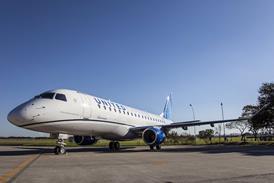A survivor from the very light jet (VLJ) boom-and-bust cycle of the last decade, the Stratos 714 made an unlikely debut at the Experimental Aircraft Association’s AirVenture fly-in in Oshkosh, Wisconsin on 24 July.
Redmond, Washington-based Stratos Aircraft had produced only a mock-up when the global financial crisis in 2009 wiped out most of at least 11 VLJ competitors by the end of the decade. But the company managed to survive with incremental rounds of financing, so that eight years on the Stratos 714 exists as a flying prototype, with a second prototype funded and a fully-equipped production facility.
“While the [mock-up displayed at previous AirVenture events] generated interest, a lot of the press, having seen so many failures, weren’t too optimistic about us,” says Stratos chief sales officer Kevin Jordan. “But we prevailed and managed to make it to get primary funding.”
The first Stratus 714 prototype, featuring bifurcated inlet ducts, achieved a first flight on 21 November last year. The company is also funded to produce a second prototype, and to conduct flight envelope expansion tests and work on ground test articles, says Fred Hadlich, prototype production manager.
Since first flight, the Stratos 714 – whose designation implies a Mach 0.7 speed, single Pratt & Whitney Canada JT15-D5 engine and four passenger seats – has accumulated 70 flight hours, expanding the envelope to an indicated air speed of 250kt (462km/h), says chief executive Michael Lemaire.
The next – and perhaps most difficult – step is to raise money from investors to build and fly a production-conforming aircraft to achieve an airworthiness certificate. As soon as the proof-of-concept aircraft achieves a targeted 400kt cruise speed in flight tests, Stratos Aircraft will begin a fundraising campaign.
“We expect [certification] three to four years after being funded,” Lemaire says. “So many things are still in the air, but we are here with an airplane that really flies. That’s the start of the adventure.”
In the absence of certification funding, the company’s back-up plan is to start producing kits for the homebuilt market, Hadlich says.
Source: FlightGlobal.com


























